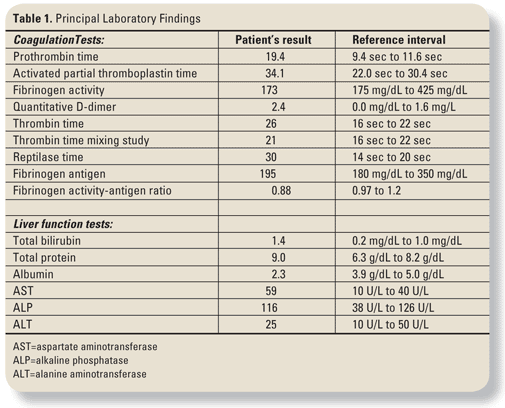
Exams and Tests
 Exams and Tests
Exams and Tests
Cirrhosis is a potentially life-threatening condition that occurs when inflammation and scarring damage the liver. A physical examination and medical history will be done first to assess symptoms of liver disease, to see whether liver disease is severe enough to cause signs of cirrhosis, and to help determine possible causes of liver damage.
A combination of tests may be used to diagnosis cirrhosis when a physical examination and medical history suggest that the condition may be present. Blood tests may help your doctor check for inflammation of the liver, assess liver function, and diagnose the cause of cirrhosis. Other tests provide images of the liver to look for tumors and blocked bile ducts and can be used to evaluate liver size and blood flow through the liver.
Liver biopsy, in which a sample of liver tissue is removed and analyzed, also may be done. It is the only test that can confirm a diagnosis of cirrhosis.
Blood tests that assess liver function
Measuring the levels of certain chemicals produced by the liver can help evaluate remaining liver function. Blood tests may be used to measure:
Albumin and total serum protein. Albumin is a type of protein. Liver disease can cause a decrease in protein levels in the blood.
Partial thromboplastin time or prothrombin time/INR. These tests measure blood-clotting factors that are produced in the liver.
Bilirubin. Bilirubin is produced when the liver breaks down hemoglobin, the oxygen-carrying substance in red blood cells. Cirrhosis may cause elevated bilirubin levels, which causes jaundice.
Blood tests for inflammation of the liver
Blood tests may be done to look at levels of liver enzymes. These tests can help show whether there is ongoing liver inflammation, although some people with cirrhosis have normal liver enzymes. The blood tests include:
Aspartate aminotransferase (AST). An increased AST level (also called SGOT) may indicate injury to the liver and the death of liver cells.
Alanine aminotransferase (ALT). An increased ALT level (also called SGPT) also may indicate injury to the liver and the death of liver cells.
Lactate dehydrogenase (LDH). An increased LDH level also may indicate injury to the liver and the death of liver cells.
Alkaline phosphatase (ALP). An increased ALP level may indicate blockage of bile ducts.
Gamma-glutamyl transpeptidase (GGT). An increased level of GGT is seen with alcohol use or diseases of the bile ducts. The level of GGT also may increase with the use of certain medicines, such as dilantin and phenobarbital. But GGT may increase without inflammation.
Blood tests that may diagnose a cause of cirrhosis
Tests that may be done to check for conditions that may cause cirrhosis include:
Antinuclear antibodies (ANA). ANA testing and anti-smooth-muscle antibody (ASMA) testing may help findautoimmune chronichepatitis.
Antimitochondrial antibody test (AMA), which may help detect primary biliary cirrhosis.
Ferritin and iron tests, which may help diagnose iron overload, or hemochromatosis.
Virus antibody testing for hepatitis B and hepatitis C or tests for hepatitis virus genetic material, which may help diagnose infection with certain hepatitis viruses.
Blood alcohol level (BAL) tests. These tests may detect alcohol use, which can cause alcoholic cirrhosis.
Serum ceruloplasmin testing, which may help diagnose Wilson’s disease.
Alpha1-antitrypsin level. This may diagnose a condition in which people lack this protein (alpha1-antitrypsin deficiency).
Tests that provide an image of the liver
Imaging tests can check for tumors and blocked bile ducts and can be used to evaluate liver size and blood flow through the liver. These tests include:
Abdominal ultrasound.
Computed tomography (CT) scan of the abdomen (including the liver, gallbladder, and spleen).
Magnetic resonance imaging (MRI) scan of the abdomen.
Liver and spleen scan (rarely done).
Other tests
Other tests also may be done to confirm a diagnosis of cirrhosis or to look for possible complications. These include:
Liver biopsy, the only test that can directly confirm a diagnosis of cirrhosis. Examination of liver tissue also may show signs of inflammation. A liver biopsy may be done by inserting a needle between two of the right lower ribs to remove a sample of liver tissue. The tissue sample is then analyzed.
Paracentesis, to help diagnose the cause of fluid buildup in the abdominal cavity (ascites) or to detect infection in the abdominal fluid (spontaneous bacterial peritonitis). Paracentesis is a procedure in which a needle is inserted through the abdominal wall to remove fluid from the abdominal cavity. The fluid can then be analyzed.
Endoscopy, to look for enlarged veins (varices) in the digestive tract that could cause variceal bleeding. Endoscopy allows a doctor to examine the inside of organs, canals, and cavities in the body using a thin, flexible, lighted viewing instrument called an endoscope.
Endoscopic retrograde cholangio pancreatogram (ERCP), to look inside the tubes (bile ducts) that drain the liver, pancreas, and gallbladder. ERCP may be done if your doctor thinks a condition called primary sclerosing cholangitis (PSC) might be leading to your liver problems.
Alpha-fetoprotein (AFP) testing, to screen for cancer of the liver (hepatocellular carcinoma). This is a blood test.
Ammonia testing, to look for excess ammonia in the blood, which can cause altered brain function (encephalopathy).